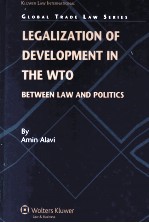图书介绍
LEGALIZATION OF DEVELOPMENT IN THE WTO BETWEEN LAW AND POLITICS2025|PDF|Epub|mobi|kindle电子书版本百度云盘下载

- AMIN 著
- 出版社: WOLTERS KLUWER
- ISBN:
- 出版时间:2009
- 标注页数:245页
- 文件大小:13MB
- 文件页数:261页
- 主题词:
PDF下载
下载说明
LEGALIZATION OF DEVELOPMENT IN THE WTO BETWEEN LAW AND POLITICSPDF格式电子书版下载
下载的文件为RAR压缩包。需要使用解压软件进行解压得到PDF格式图书。建议使用BT下载工具Free Download Manager进行下载,简称FDM(免费,没有广告,支持多平台)。本站资源全部打包为BT种子。所以需要使用专业的BT下载软件进行下载。如BitComet qBittorrent uTorrent等BT下载工具。迅雷目前由于本站不是热门资源。不推荐使用!后期资源热门了。安装了迅雷也可以迅雷进行下载!
(文件页数 要大于 标注页数,上中下等多册电子书除外)
注意:本站所有压缩包均有解压码: 点击下载压缩包解压工具
图书目录
Chapter 1 Introduction1
1.1 The Context1
1.2 The Legalized Trading System6
1.2.1 Developing Countries7
1.2.2 The DSM8
1.2.3 Effectiveness of the S&DT Provisions10
1.2.4 S&DT Provisions11
1.3 The Theory12
1.3.1 Regime Theory13
1.3.2 The Legal Approach15
1.3.3 Obligation, Precision, and Coherence17
1.3.4 Interpreting Development18
1.4 The Book18
1.4.1 Part 1: Development as a Legal Regime19
1.4.2 Part 2: Success or Failure21
1.4.3 Part 3: Findings21
1.5 Conclusion22
Chapter 2 Regulation of International Relations: A Legal Reading of Regime Theory25
2.1 Introduction25
2.2 International Law and International Relations26
2.2.1 Regime Theory28
2.3 The Debates and Three Traditional Approaches29
2.4 Legal Approach37
2.4.1 Issue Area37
2.4.2 Regulating an Issue Area39
2.4.3 Between Law and Politics41
2.4.4 Managing Issue Areas43
2.4.5 International Law45
2.4.6 Actors' Expectations or Actors' Options47
2.4.7 Compliance48
2.4.8 Principles51
2.4.9 Norms and Rules54
2.4.10 Legalization and Changes to Legal Regimes59
2.4.11 Measuring Obligation, Precision, and Coherence60
2.4.12 Legalization and De-legalization63
2.4.13 Legal Dispute Settlement and Interpreting Legal Rules64
2.5 Conclusion70
Chapter 3 Developing Countries' Special Status in the GATT and WTO73
3.1 Introduction73
3.2 The Bretton Woods Conference73
3.3 GATT: A Brief History75
3.3.1 Multilateral Negotiations80
3.3.2 Non-discrimination80
3.3.3 Use of Quantitative Restrictions81
3.3.4 Transparency81
3.3.5 Reciprocity81
3.3.6 Settlement of Disputes82
3.3.7 Consensus Decision-Making82
3.3.8 GATT's Exceptions83
3.4 The S&DT Regime84
3.5 The Evolution of the S&DT Regime86
3.6 The First Phase: World in Harmony (WWII-1973)87
3.7 The Second Phase: North-South Conflict (1973-1981)92
3.8 The Third Phase: Developing Countries Split (1981-1987)94
3.9 The Fourth Phase: Consolidation of the Position of Developing Countries Within the System (1987-1999)95
3.10 WTO: The ‘New' Regime98
3.10.1 Broadening the GATT: The Issue Area99
3.10.2 Single Undertaking: The Rule99
3.10.3 WTO: The Organization99
3.11 The Fifth Phase: The New Battle-Ground (1999-?)101
3.12 Conclusion103
Chapter 4 Dispute Settlement in GATT to WTO105
4.1 Introduction105
4.2 Constitutionalization of International Trade107
4.3 Legalization of the DSM109
4.4 Dispute Settlement During GATT111
4.5 The Development of GATT's System of Dispute Settlement114
4.6 The Dispute Settlement Mechanism117
4.6.1 The Dispute Settlement Body118
4.6.2 The DSU118
4.6.3 Panels118
4.6.4 The Appellate Body119
4.6.5 The WTO Secretariat and the DSM119
4.6.6 Disputing Parties120
4.7 How Does the DSM Work?120
4.7.1 The Consultation Phase120
4.7.2 The Ruling Phase: Ruling by the Panel and/or the Appellate Body121
4.7.3 The Implementation Phase122
4.7.4 The Retaliation Phase123
4.8 Comparing the GATT Dispute Settlement System with the DSM125
4.8.1 The Institution of the System125
4.8.2 Blocking of Decisions No Longer Possible125
4.8.3 The Rulings are Binding on the Disputing Parties126
4.8.4 The DSM Covers All Agreements126
4.8.5 Rulings and Agreed Solutions Must Be in Line with WTO Agreements126
4.8.6 The Appellate Body Is Established as a Decision-Making Forum of ‘Second Instance'126
4.8.7 Mandatory Use of the DSM126
4.9 Functions of the DSM127
4.9.1 Securing a Rule-Based System (DSU Article 3)127
4.9.2 Clarifying the WTO Agreements (Article 3.2.)128
4.9.3 Settling Disputes129
4.10 Legalization of the Settlement of Disputes130
4.11 The Political DSM135
4.12 Legalization of Development in the DSU137
4.12.1 Article 3.12: Use of the 1966 Decision as an Alternative to the DSU in the Consultation Phase140
4.12.2 Article 4.10: During Consultations the Interests of Developing Countries Should be Recognized143
4.12.3 Article 8.10: Panellists from Developing Countries143
4.12.4 Article 12.10: Different Deadlines during Consultations and Panel Proceedings144
4.12.5 Article 12.11: Panels' Analyses of the Invoked S&DT Provisions145
4.12.6 Article 21.2: During the Implementation Phase the Interests of Developing Countries Should Be Recognized146
4.12.7 Article 21.7: Implementation of Matters Raised by a Developing Country146
4.12.8 Article 21.8: Impact of Measures Complained about on Developing Countries during the Implementation Phase147
4.12.9 Article 24.1: Special Procedures Involving Least-Developed Countries148
4.12.10 Article 24.2: Special Procedures Involving Least-Developed Countries148
4.12.11 Article 27.2: Secretariat's Assistance to Developing Countries149
4.13 Conclusion: A Theoretical View on the DSM149
Chapter 5 On the (Non-)effectiveness of the WTO's Special and Differential Treatments in the Dispute Settlement Process153
5.1 Introduction153
5.2 The Invoked S&DT Provisions, Cases and Rulings156
5.3 Dispute Settlement Understanding157
5.3.1 Articles 12.10 of the DSU157
5.3.2 Article 12.11 of the DSU158
5.3.3 Article 21.2 of the DSU160
5.3.4 Article 24.1 of the DSU162
5.4 Agreement on Implementation of Article Ⅵ(Anti-Dumping) of the GATT 1994163
5.5 Agreement on Subsidies and Countervailing Measures166
5.5.1 Article 27.3 of the SCM166
5.5.2 Article 27.4 of the SCM167
5.6 Balance of Payments Agreement169
5.6.1 Article ⅩⅤⅢ.B of the GATT 1994169
5.7 Agreement on Trade-Related Aspects of Intellectual Property Rights171
5.7.1 Article 65.4 of the TRIPs172
5.8 Licensing Agreement173
5.9 Agreement on Safeguards173
5.10 Agreement on Agriculture175
5.11 General Agreement on Trade in Services (GATS)176
5.12 Enabling Clause177
5.13 Why have the Invoked S&DT Provision Been Less Effective?179
5.14 Conclusion184
Chapter 6 African Countries and WTO's Dispute Settlement Mechanism189
6.1 Introduction189
6.2 Developing Countries and the DSM190
6.3 An Overview of the Current DSM Negotiations196
6.4 The African View of the DSU's Problems198
6.5 Entry Barriers199
6.6 Weak Retaliation203
6.7 Lack of Development-Friendliness204
6.8 Conclusion210
Chapter 7 Conclusion213
7.1 Theoretical Contributions of this Study213
7.2 Empirical Findings of this Study218
7.3 Future StepsList of References223
Index241